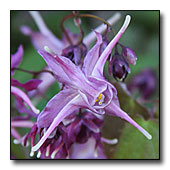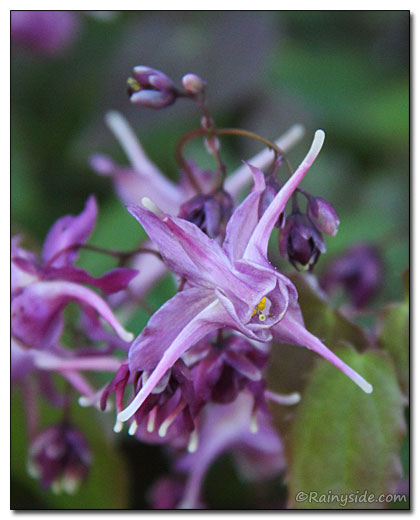Epimedium grandiflorum 'Lilafee'
BISHOP'S HAT, BISHOP'S MITRE
syn. 'Lilac Fairy'
Family: Berberidaceae
Pronounced: ep-ee-MEE-dee-um grand-i-FLO-rum

Quick Jumps
Growing Guide
Rainy Side Notes
GROWING GUIDE

Origin:
Garden.
Plant Group:
Perennial.
Hardiness:
Sunset zones: 2-9, 14-17.
USDA zones: 5-9.
Heat zones: 8-5.
Mature size:
Height: 8-10 inches (20-25 cm).
Width: 12 inches (30 cm).
Flowering period:
Mid-to late spring.
Flowering attributes:
Racemes of long-spurred, lavender flowers, held well above the foliage.
Leaf attributes:
Evergreen, heart-shaped, bronze-purple tinted foliage emerges in spring and later turns green. In fall leaves take on tints of red.
Growth habit:
Clump forming
Light:
Partial to full shade.
Soil:
Humus rich, fertile, well-drained, dry to medium soil.
Propagation Methods:
Divide in autumn or after flowering.
Pruning Methods:
Shear plants back to the ground in late winter, to keep the flowers above the foliage.
Rainy Side Notes

Epimedium nesteled in with a dwarf mondo grass (Ophiopogon japonicum) and Heucherella 'Sweet Tea'.
E. grandiflorum, originating in Japan, is parent to many beautiful hybrids such as E. x rubrum, E. x versicolor and E. x youngianum. However, it is a beautiful species in its own right.
The cultivar E. grandiflorum 'Lilafee' has the violet purple flowers and is a knockout in the shade garden. Synonymous with the name, 'Lilac Fairy', it is sometimes sold under that name. This is a worthy spring flower for a child's (or adult's) fairy garden, as it is an effortless plant to grow.
Use in shade or woodland gardens as a ground cover or edger along walkways. The orchid-like flowers in spring are pretty little things, but the foliage is beautiful year round. Late winter, when the leaves get a bit ratty looking, you cut the foliage down to make way for the new season's vegetation and flowers. The new growth is bronze-purple in color, turning green for the summer and in fall taking on tints of red.
Photographed in author's garden.
A Pacific Northwest Plant of the Week (2013)

Gardening for the Homebrewer: Grow and Process Plants for Making Beer, Wine, Gruit, Cider, Perry, and More
By co-authors Debbie Teashon (Rainy Side Gardeners) and Wendy Tweton
Copyright Notice | Home | Search | Perennials

